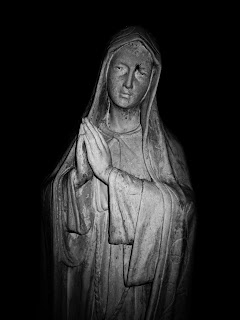Knockbreda Cemetery
Situated on a long, sloping hill between Church Road and Saintfield Road in south Belfast, Knockbreda Cemetery is one of the oldest cemeteries in the city. I lived quite close to this cemetery for five or six years and, naturally, found myself wandering through it fairly frequently as, rain or shine, day or night, it not only offered peace and quiet, but pretty views of Belfast city, Black Mountain and Cave Hill. The cemetery is built around the little parish church nestled on the pinnacle of the hill, which was consecrated in 1737. It was designed by Richard Cassels, a lauded Palladian architect, and built by Lady Middleton, mother of the first Viscount Dungannon, Arthur Hill-Trevor. According to a nearby information board, Knockbreda Cemetery was a ‘fashionable place to spend eternity’ as it became renowned for its funerary monuments and exquisite mausolea which were erected by some of the wealthiest, most influential families in Ulster at that time.
Amongst those buried here are Sir Charles Lanyon, an architect responsible for designing some of Belfast’s most famous buildings including Queen’s University, the Crumlin Road Gaol and the very-grand-indeed Customs House which overlooks the River Lagan as it flows into the Irish Sea. Also interred at Knockbreda Cemetery are Samuel Nielsen, a member of the revolutionary Society of United Irishmen and founder of the Northern Star newspaper, and merchant Waddell Cunningham, whose wealth was accumulated through his sugar plantation operated by slaves in the Caribbean. According to local folklore, his funeral procession was led by two lions who also remained at his tomb for a week after his burial to deter grave-robbers and body snatchers.
One of the more unusual graves is that of Alexander Corry whose epitaph notes that he died when he was ‘accidentally strangled by his neck handkerchief being caught whilst turning at a lathe in his own works, Belfast 2nd December 1859 aged 25 years’. It concludes with a helpful reminder of the brevity and uncertainty of life: ‘We cannot tell who next may fall, Beneath thy chastening rod.’
The following collection of photographs were taken over my many visits to the cemetery, beginning in 2012 and continuing through to today. Quite a few were taken when a friend and I embarked on a ‘Photo a Day for a Year’ project (the results of which you can check out here). Some were taken on misty autumn mornings, others on late summer evenings when shadows were long, and a few others were taken after dark, in the dead of night, as I wandered there alone among the dead...
For more information and writings on Knockbreda Cemetery, its history and those buried within it, check out Knockbreda: Its Monuments & People.
Amongst those buried here are Sir Charles Lanyon, an architect responsible for designing some of Belfast’s most famous buildings including Queen’s University, the Crumlin Road Gaol and the very-grand-indeed Customs House which overlooks the River Lagan as it flows into the Irish Sea. Also interred at Knockbreda Cemetery are Samuel Nielsen, a member of the revolutionary Society of United Irishmen and founder of the Northern Star newspaper, and merchant Waddell Cunningham, whose wealth was accumulated through his sugar plantation operated by slaves in the Caribbean. According to local folklore, his funeral procession was led by two lions who also remained at his tomb for a week after his burial to deter grave-robbers and body snatchers.
One of the more unusual graves is that of Alexander Corry whose epitaph notes that he died when he was ‘accidentally strangled by his neck handkerchief being caught whilst turning at a lathe in his own works, Belfast 2nd December 1859 aged 25 years’. It concludes with a helpful reminder of the brevity and uncertainty of life: ‘We cannot tell who next may fall, Beneath thy chastening rod.’
The following collection of photographs were taken over my many visits to the cemetery, beginning in 2012 and continuing through to today. Quite a few were taken when a friend and I embarked on a ‘Photo a Day for a Year’ project (the results of which you can check out here). Some were taken on misty autumn mornings, others on late summer evenings when shadows were long, and a few others were taken after dark, in the dead of night, as I wandered there alone among the dead...
 |
| A little 'tell-tale heart'... |
Knockbreda Cemetery after dark...
For more information and writings on Knockbreda Cemetery, its history and those buried within it, check out Knockbreda: Its Monuments & People.



































